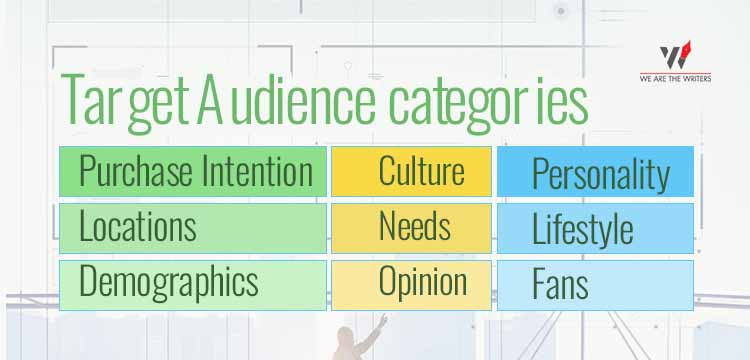The propagation of a business is only possible with the active presence and participation of its customers. In this digital ecosystem, where it’s possible to choose customers, they are referred to as the Target Audience.
The digital wave has transformed the game of business and its runners are now focusing on its elements that hold the utmost importance. Target audience is one such element that affects businesses greatly.
Read our Blog for Digital Marketing Ideas for Small Business: 11 best digital marketing ideas for small businesses
Table of Contents
What is Target Audience?
As the name suggests the target audience of a business is the one that it is deliberately making efforts to reach. It is also called the intended audience. The business advertises, promotes and reaches out to the audience that it wants to target. The share of customers that promise best results for your brand and make up the most elite section of your customer base. .
The motive behind targeting an audience is to make them buy your products and services and it is based on the interests, goals, educational background and circumstances that meet the ones of your business’s ideal customer.
The difference between the targeted audience and customer base is that the former can actually buy your products and services. They have the means and the intention to make a purchase from your brand. Your customer base includes everyone that visits your website. Not all of your visitors come with an intention to purchase.
Read our blog steps to create Digital Marketing Strategy for brand: 8 easy steps to create Digital Marketing Strategy for a brand!
Target audience definition

The most simplified target audience definition says, ‘customers who a business makes efforts to connect to’. But here is a catch, a business is free to make its own target audience definition. It is completely aligned to what you ,as a business, aim for.
A business can aim for various things such as increased sales, higher website rankings, better customer service, etc. Businesses craft content and strategies for the audience that they want to target in order to get the maximum returns of investment (ROI).
Suggested Blogs:
- Why is User Experience an important Ranking Factor in 2022 ?
- What is Search Intent ? A Promising factor for Website Ranking on SERPs
- SEO CHECKLIST TO RANK NO.1 in GOOGLE’S SERP
Why does Knowing Your Target Audience matter?

“Defining your target audience is the first and most essential step towards success for any company or business, especially if you are just getting started” says Neil Patel
Neil Patel
Analysing the target audience is undoubtedly the most rewarding practice for your business. Your study of the audience that you intend to target impacts your marketing strategies and everything else that you plan for the development of your business.
Apart from the advantages your business gets such as increased returns of investments, better marketing strategy and optimised content strategy it also helps greatly in understanding what to create. Be it content, strategies or products. If you know who the receivers are, you will create and supply accordingly.
Read more about Content Strategy: What is Content Strategy and why do you need it right now ?
The marketing and content strategy for them is different from other customers. The strategies are created with a different approach than that of the others.
Not only marketers and businesses, even the customers themselves look for a targeted approach by the business. It makes them feel that the marketer is approaching them in a more personalised manner. It gives them a sense of importance and priority. A personalised targeting makes the audience feel that the marketer is not just approaching them for their selfish purpose but is also putting efforts in earning them.
Targeting the audience strengthens your relationship with them and makes them more likely to buy your businesses’ products and services. Statistics say that more than 80% of customers are more likely to respond to businesses that interact in a personalised manner.
To understand the importance of finding a target audience, you need to understand what will happen when you are devoid of one. As simple as it could be, you as a brand do not have any idea who your best customers are. Your products and services are not created with having their consumers in mind.
The brand’s approach to its customers should always strike a chord with them and make them believe that they are also a very crucial part of the whole process.
Read our blog on Brand Building Via Social Media in 2022: Thinking of Brand Building ? Social Media is the best way in 2022 !
There is a difference between having customers and a dedicated audience. Customers are not necessarily your purchasing audience whereas, your intended audience is far more likely to make evident purchases that help you generate revenue.
The intended audience is your legitimate audience. They are relevant to your business as all the efforts you put in adhering to them does not go in vain and you get your returns on investment.
Important roles of your Target Audience.
Your target audience’s primary connection to your business is dependent upon the purchasing decisions. Understanding them is extremely crucial, the particular reason is that they have a direct role to play in the purchasing paths.
Your intended audience has 2 major roles to play, the decision maker and the supporter.
The Decision Maker
One of the ways of selling your products and services is to influence the decision maker, i.e, the actual purchaser of the product. This is the person who ultimately makes the purchase decision. If you as a brand are able to cater to the actual purchaser, the decision maker and influence them, into the act of purchasing, they are your intended audience.
The Supporter
The supporter is the one who does not actually spend on the products but influences the one who does. Look at it this way, you can target people who are not eligible to spend and purchase your products or services but can be a massive influence to the people who are eligible. For example, kids. They are not the ones who make the direct purchase but are primary influencers into the purchasing of kids products. Targeting them would be the best practice to follow if you have a business in that niche.
Target Audience categories

There are various categories of target audiences divided on the basis of cultures, location, interests, intent and more.
Interest
Customers can be differentiated and identified on the basis of their interests and preferences of the most basic aspects of life. But the same preferences can prove extremely beneficial in deciphering the customer personas.
Tapping those areas of interest generate meaningful connections with the customer and eventually brand loyalty from them.
Purchase Intention
Targeting the audience is in a big way targeting their pain points. The audience knows what they are looking for and they are ready to make a purchase. You, as a brand, just have to deliver the message to your customers, offering the products they are looking for.
Locations
Customers can be targeted on the basis of where they are from. Any information that belongs to the same area as them or the areas of close proximity will be helpful in targeting that reach.
Demographics
One way is to directly aim for the customers who fall in the age group of people who are most likely to use what your brand is offering. For example, knee caps are for the older generations. The target audience will be dominated by the elderly.
Culture
Culture includes music, art, taste, dressing etc. there can be a lot of points which the brand can use as the targets. All of these things that an individual associates with culture are deeply rooted inside their minds and can actually be a gateway to the pandora’s box called the mind.
Cultures are also shared by a lot of people and a large number associate it in a similar manner.
Needs
If your brand is able to decipher the needs of your audience, you will never run out of things to supply. This category actually demands lesser efforts than the others and the particular reason for that circumstance is that there is no complicated connotation involved in the identification process. The needs and desires are overtly expressed by the customers and you only need to provide just for that.
Opinion
Customers sitting in different parts of the world can have similar opinions on a product. That makes every one of them the targeted or the intended audience.
Personality
Something as intimate as personality traits can be a deciding factor in crafting the messages for the audience of a movie for people with a certain sense of humor.
Lifestyle
Another type of target audience can be the ones on the basis of their lifestyle. On the basis of how people choose to live their daily life, do the most basic chores and how they spend their quality time. A product can be of common interest to people who choose to do it in similar ways.
For example, Alexa is a product liked by almost everyone who loves music and is a tech freak.
Fans
Fans are the most passionate customers. The scenario depends much on the feelings of love, admiration, attraction, etc. for example, a fam of Superman comics will be the perfect target audience for any kind of merchandise related to Superman.
Read our Blogs:
- Paid Advertising vs Content Marketing [ Advantages+Challenges]
- 4 KEY SEO benefits for business | How to write SEO Friendly content
Summing Up
Think of your target audience as the ones who are most prime to your brand. There can be a distinction in your customer base based on how active and loyal they are. The ones that you find most promising and potentially active make up your intended audience. Not all your customers can be your targeted audience. Only a quarter of them will be in the inner circle of your overall customer base.





 WhatsApp
WhatsApp